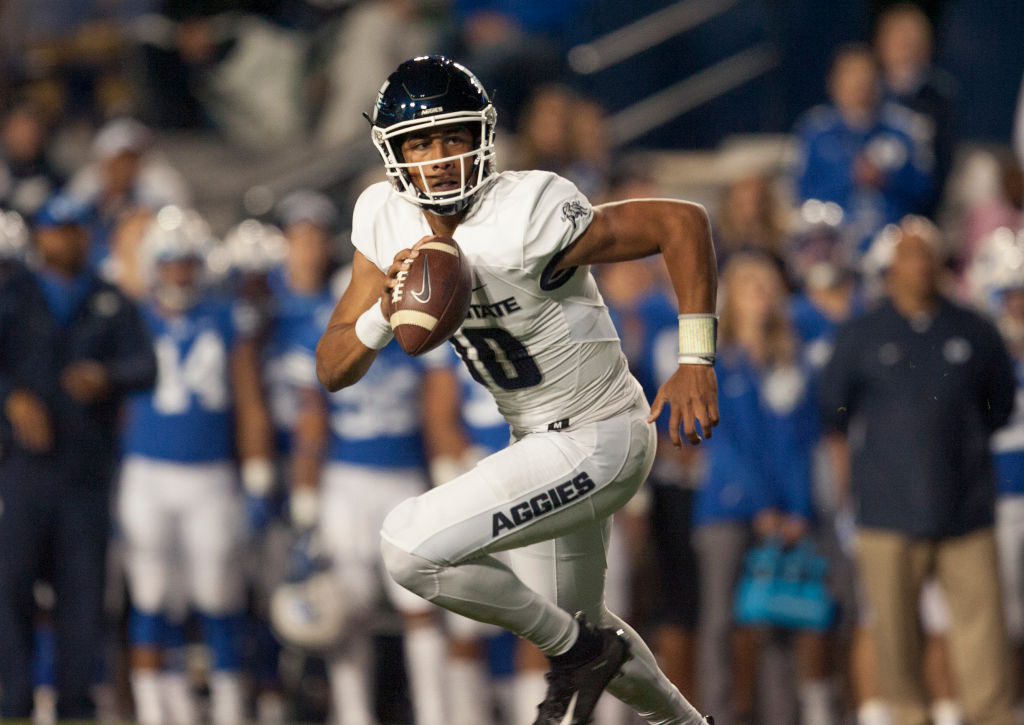NFL
Green Bay Packers QB Jordan Love Has History on His Side in 2020

The two schools of thought that emerged once the Green Bay Packers surprised the NFL by drafting Jordan Love on Thursday had the Utah State quarterback either rotting on the bench for two years or moving incumbent Aaron Rodgers out the door by the start of the 2021 season.
Depending upon how Rodgers is viewed, those are either the best- or the worst-case scenarios. History tells us which is wrong: Barring an injury, it will be almost impossible to keep Love off the field this fall.
Against all odds, Jake Locker is suddenly relevant to Aaron Rodgers
It might seem odd to bring up Jake Locker’s 2011 season in a conversation about the 2020 Green Bay Packers. But Locker matters in the discussion about Aaron Rodgers and Jordan Love for a specific reason. The Tennessee Titans drafted Locker eighth overall out of Washington in 2011, and he backed up Matt Hasselbeck, who turned 36 years old during his 13th NFL season.
Coincidentally, Hasselbeck has a Packers connection, having been drafted by Green Bay in 1998 at a time when seven-year starter Brett Favre was coming off back-to-back 13-3 records. The Packers traded Hasselbeck to the Seattle Seahawks in 2001.
Hasselbeck came over to the Titans in 2011 and was installed as the starter. Locker mopped up twice in the first half of the season and then got extensive playing time during three losses in the second half of the season, giving the Tennessee front office the opportunity to evaluate him.
The significance of the story is that Jake Locker – who only played four seasons — was the last NFL quarterback selected in the first round who did not start at least one game in his rookie season. All 24 signal-callers taken in the first round from 2012-19 started at least once as a rookie; the average for the group was a fraction under 11 rookie starts apiece.
Jordan Love probably won’t start 11 games this fall
Statistics thrown around too casually are a reminder that it’s possible to drown in a river with an average depth of three feet, so the fact that 24 rookie quarterbacks combined to start a lot of games in recent years does not mean Jordan Love will, too.
However, 24 is also a pretty large sample group. It represents players taken at the top of the draft because an NFL team was hurting at quarterback (Baker Mayfield to the Cleveland Browns). It represents players taken at the end of the first round because a team with an aging quarterback was looking toward the future (Lamar Jackson to the Baltimore Ravens). And there were plenty of quarterbacks in between whose teams faced varying circumstances.
The point is that there’s seemingly no way Jordan Love isn’t getting onto the field at some point this fall, and the odds are that he gets to prepare for the whole week at least once as the Packers’ starter. Whether it’s an injury that knocks Aaron Rodgers, 36, out for a week or a situation where Green Bay has either been eliminated from playoff contention or has already been locked into its postseason berth, the front office is going to want to take Jordan Love out for a test drive.
Assessing the Packers’ quarterback situation
Two undeniable facts point to the Green Bay Packers being more willing to move on from Aaron Rodgers now than they were a year ago. Firstly, they hadn’t used a first-round pick on an offensive skill position – let alone a quarterback — since grabbing Rodgers in 2005. Secondly, the Packers traded up four spots so that they could select Love.
Realistically, Rodgers isn’t being displaced this season or next even if Love begins making inroads. Rodgers is coming off another 4,000-yard season with 26 touchdown passes and just four interceptions. He hasn’t thrown more than eight picks in a season since 2010.
Almost as important as the fact that Rodgers’ play hasn’t shown a significant drop-off is that there are salary-cap implications because of the $134 million contract negotiated before the 2018 season. With a $57.5 million signing bonus and $78.7 million overall guaranteed, the Packers could be staring at a lot of dead money if they made a move.
A creative trade could alleviate some of that, but the market is not strong when it comes to moving a quarterback with an average salary in excess of $19 million a year.











